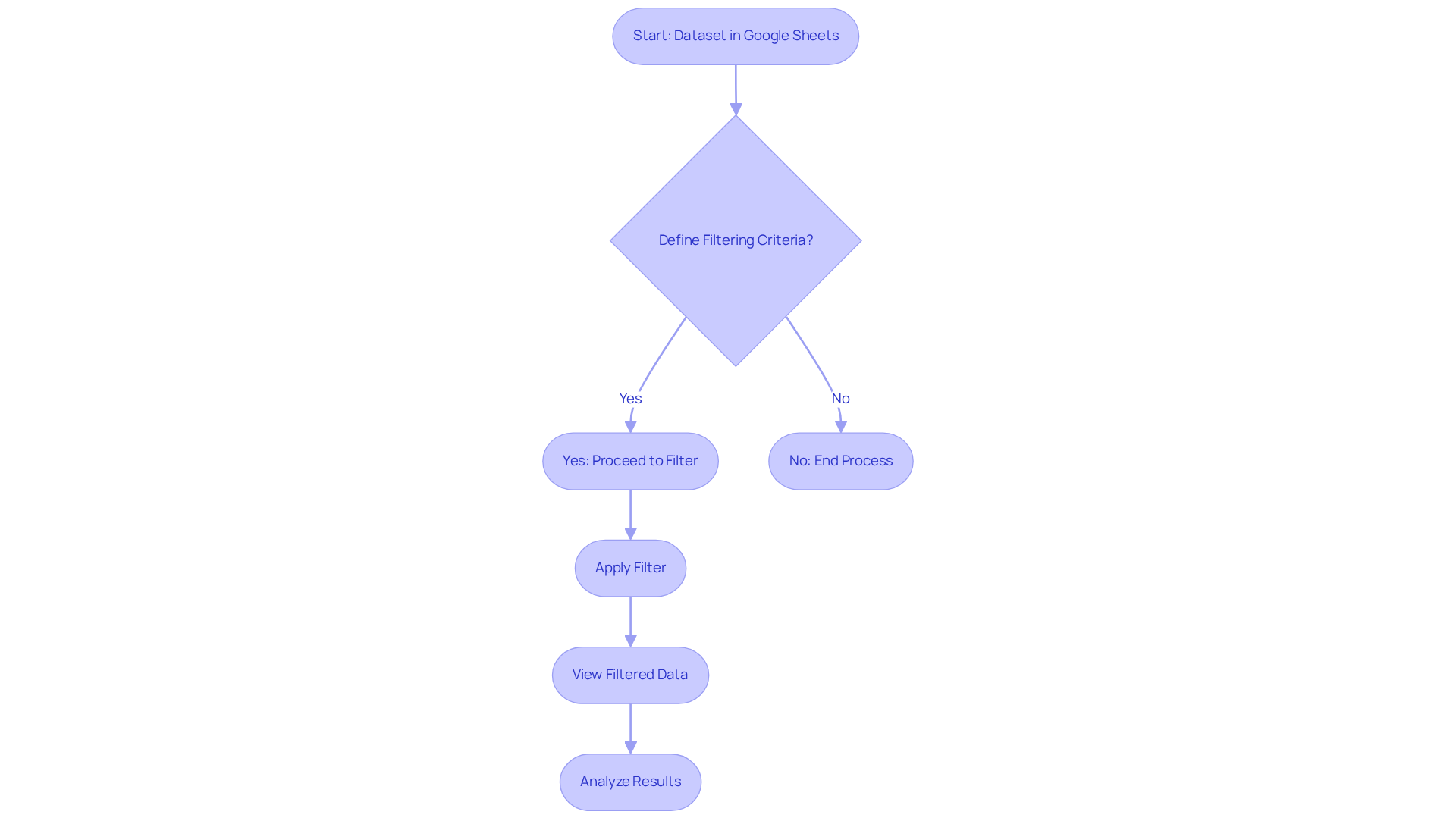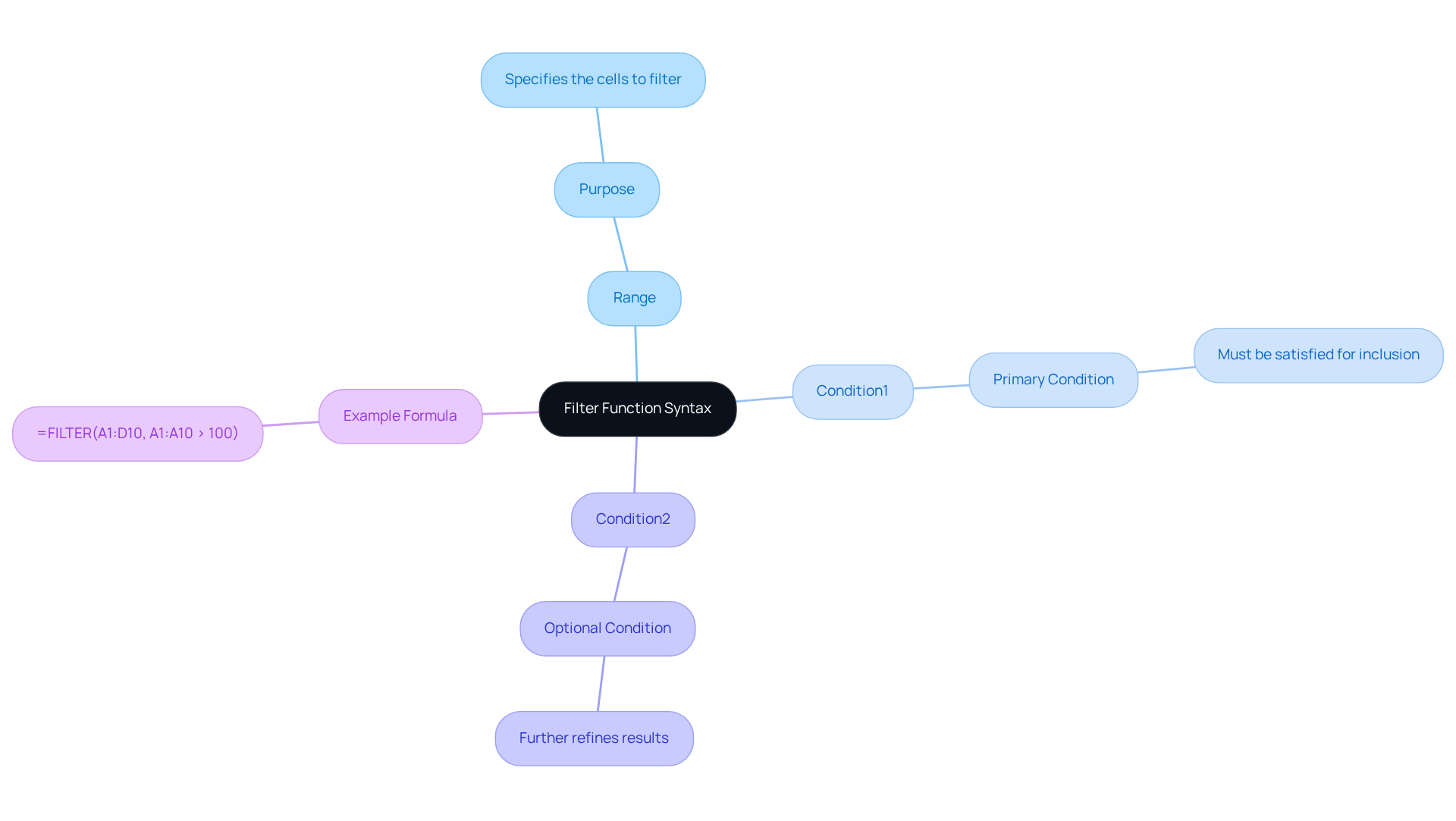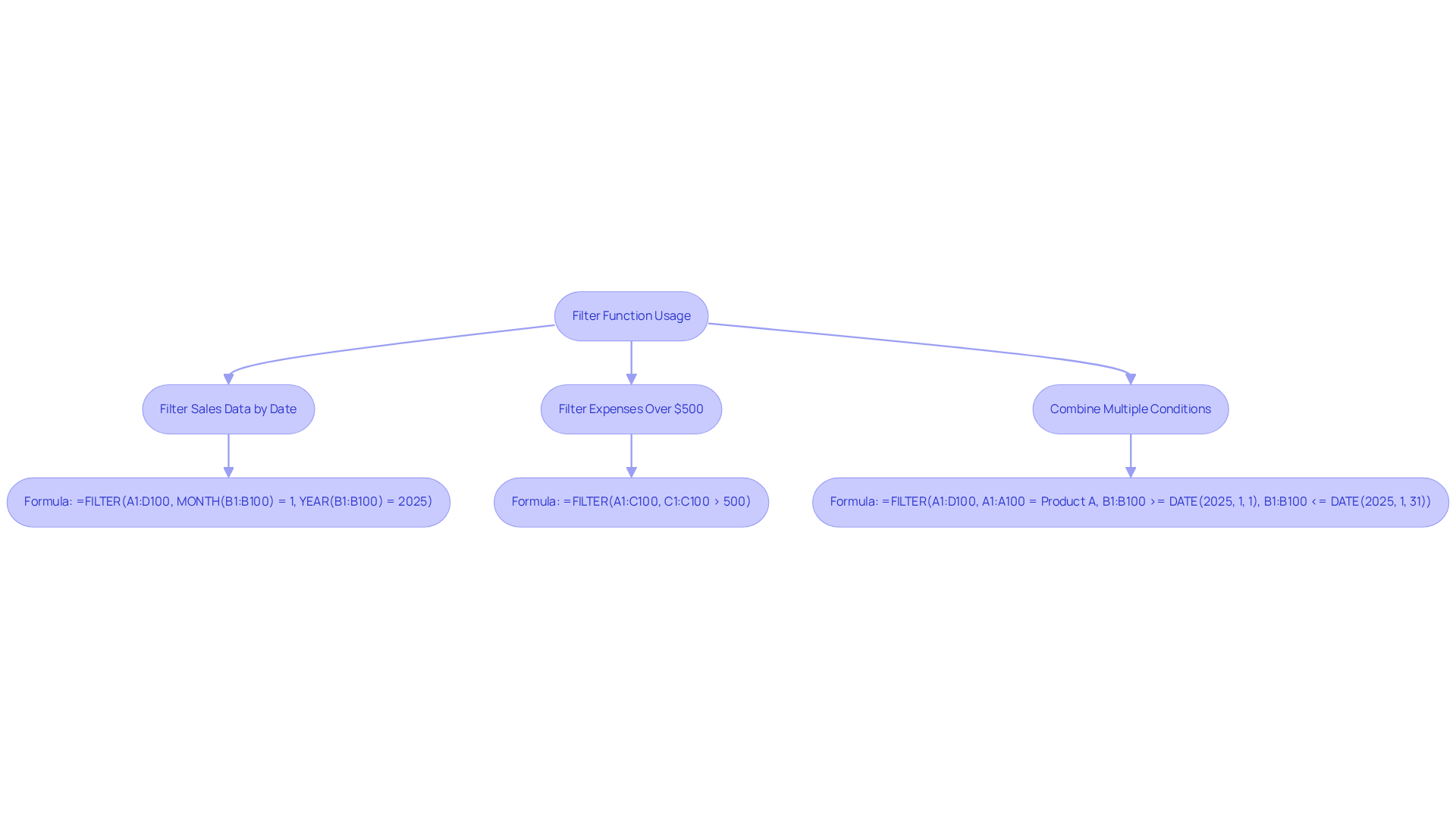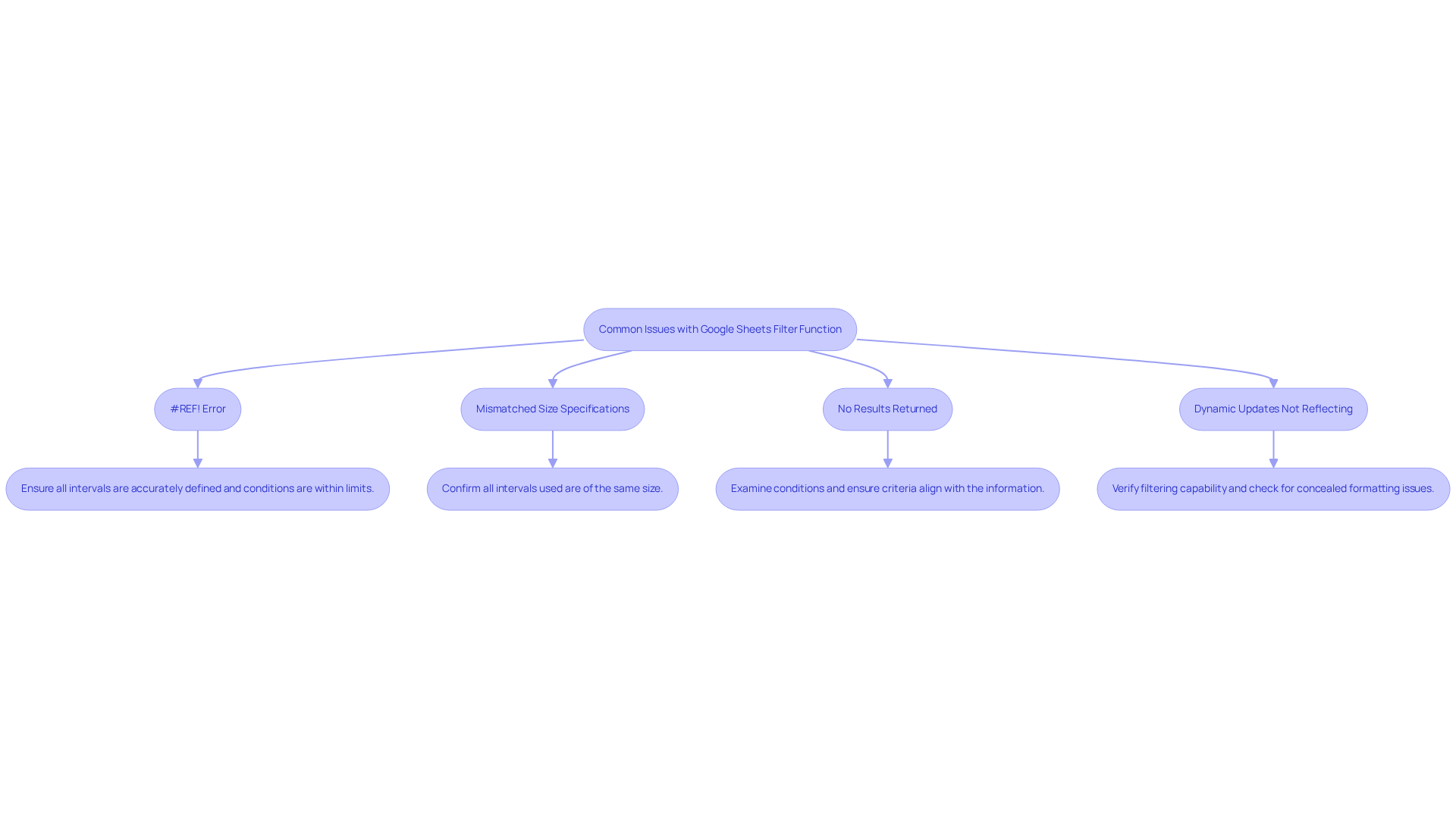Overview
The Google Sheets filter function is a critical asset for financial analysis, enabling users to extract specific data from extensive datasets based on defined criteria. This capability significantly enhances the analysis of financial performance. The article elaborates on this by detailing the function's syntax, providing practical examples of its application, and offering troubleshooting tips. Mastering this tool not only leads to improved data insights but also fosters informed decision-making in finance.
Introduction
Mastering the Google Sheets Filter Function can revolutionize the analysis of financial data, empowering users to navigate extensive datasets with precision. This robust tool not only streamlines the extraction of critical insights—such as revenues and expenses—but also significantly enhances decision-making capabilities within the finance sector. Yet, many users encounter challenges in effectively implementing this function, leading to inquiries regarding its syntax, potential errors, and best practices.
How can finance professionals harness the filter function to unlock deeper insights and drive superior business outcomes?
Understand the Google Sheets Filter Function
The Google Sheets filter function stands as a formidable tool, empowering users to extract specific information from extensive datasets based on defined criteria. It allows for the filtering of rows within a range, showcasing only those that align with the specified conditions. This capability proves particularly advantageous in financial analysis, where isolating elements such as expenses, revenues, or specific transactions is often necessary. By leveraging the filtering option, one can streamline the analytical process, facilitating the extraction of insights from complex datasets.
Consider a dataset containing sales information for various products; the filtering tool enables you to display only the sales for a particular product or within a designated date range. This targeted methodology significantly enhances your ability to analyze financial performance effectively. Notably, 31% of finance and accounting professionals utilize Google Sheets for real-time dashboards, underscoring its relevance in the industry.
Recent enhancements to Google Sheets have further refined the google sheets filter function, allowing for more intricate queries and improved data manipulation capabilities. Financial analysts emphasize the importance of information filtering in spreadsheet applications, asserting that it greatly aids in making informed decisions based on precise insights. As Robert A. Lee aptly states, "Google Sheets isn’t just a spreadsheet tool; it’s a platform reshaping how individuals and businesses collaborate with data." By mastering the filtering mechanism, finance professionals can elevate their analytical skills and attain superior business outcomes.

Learn the Syntax of the Filter Function
The syntax for the Filter function in Google Sheets is as follows:
=FILTER(range, condition1, [condition2, ...])
- range: This represents the range of cells that you want to filter.
- condition1: This is the primary condition that must be satisfied for the rows to be included in the output.
- condition2: This optional additional condition can further refine the results.
For instance, if you aim to filter a dataset in cells A1 to D10 where the values in column A exceed 100, you would write:
=FILTER(A1:D10, A1:A10 > 100)
This formula will return all rows from the specified range where the value in column A surpasses 100. Understanding this syntax is crucial for effectively leveraging the filtering mechanism in your financial analyses.

Explore Sample Usage of the Filter Function
Effective utilization of the Filter function in financial analysis can significantly enhance your data insights. Here are a few compelling examples:
-
Filtering Sales Data by Date: When analyzing your sales dataset located in A1:D100, you may want to isolate sales made in January 2025. The appropriate formula is:
=FILTER(A1:D100, MONTH(B1:B100) = 1, YEAR(B1:B100) = 2025)This formula efficiently filters the dataset to display only the sales recorded in January 2025.
-
Filtering Expenses Over a Certain Amount: To identify all expenses exceeding $500 within a dataset in A1:C100, implement the following formula:
=FILTER(A1:C100, C1:C100 > 500)This command will return every row where expenses surpass $500, enabling focused financial scrutiny.
-
Combining Multiple Conditions: Filtering data based on multiple criteria is also feasible. For example, to filter sales data for a specific product within a defined date range, you can utilize:
=FILTER(A1:D100, A1:A100 = "Product A", B1:B100 >= DATE(2025, 1, 1), B1:B100 <= DATE(2025, 1, 31))This formula filters the dataset to showcase sales of "Product A" that occurred in January 2025.
These examples illustrate the customization potential of the Filter function, addressing diverse analytical requirements in financial contexts.

Troubleshoot Common Issues with the Filter Function
When utilizing the google sheets filter function, users may encounter several common problems. Here’s how to address them effectively:
-
#REF! Error: This issue typically arises when the specified scope in the Filter function is incorrect or when conditions reference cells beyond the defined scope. To resolve this, ensure that all intervals are accurately defined and that conditions remain within the designated limits. As Holly Meikle notes, "If a #REF! error is left uncorrected, there is a high risk of losing entire columns, rows, or even sheets of data."
-
Mismatched Size Specifications: A "FILTER has mismatched size specifications" error indicates that the selections in your Filter operation do not share the same number of rows. Confirm that all intervals used in the process are of the same size to prevent this issue. Case studies highlight that aligning the primary set of information with the condition set is essential for avoiding this error.
-
No Results Returned: If your Filter function yields no results, it is crucial to examine your conditions. Ensure that the criteria align precisely with the information in your range. For instance, when filtering for a specific date, confirm that the date format matches the information. Utilizing tools like TRIM and CLEAN can help eliminate unwanted spaces that may lead to mismatches.
-
Dynamic Updates Not Reflecting: If filtered data does not refresh with changes in the source data, verify that you are using the filtering capability correctly and that your data range includes all pertinent rows. Concealed formatting issues may also hinder the filtering capability, so check for any discrepancies.
By understanding these common issues and their solutions, users can troubleshoot effectively while utilizing the google sheets filter function, thereby enhancing their productivity. Recent user satisfaction statistics indicate that effective error handling significantly boosts productivity, making it essential to master these troubleshooting techniques.

Conclusion
Mastering the Google Sheets Filter function is crucial for enhancing financial analysis capabilities. This powerful tool allows users to extract relevant data from extensive datasets with ease, isolating specific information based on defined criteria. By streamlining the analytical process, it facilitates informed decision-making in finance.
This article has explored various aspects of the Filter function, including its syntax, practical applications, and troubleshooting common issues. From filtering sales data by date to identifying expenses over a certain amount, the provided examples illustrate how this function can be tailored to meet diverse analytical needs. Understanding the nuances of the Filter function not only improves data manipulation but also empowers finance professionals to derive actionable insights from their analyses.
Embracing the Google Sheets Filter function is essential for anyone seeking to elevate their financial analysis skills. By leveraging this tool effectively, users can enhance their productivity, make informed decisions, and ultimately achieve superior business outcomes. Exploring the capabilities of the Filter function can transform data analysis from a tedious task into a streamlined process, paving the way for more strategic financial insights.
Frequently Asked Questions
What is the Google Sheets filter function?
The Google Sheets filter function is a tool that allows users to extract specific information from large datasets by filtering rows based on defined criteria.
How does the filter function benefit financial analysis?
The filter function helps isolate elements such as expenses, revenues, or specific transactions, streamlining the analytical process and facilitating the extraction of insights from complex datasets.
Can you provide an example of how the filter function can be used?
For instance, in a dataset containing sales information, the filter function enables users to display only the sales for a particular product or within a specific date range.
How prevalent is the use of Google Sheets among finance professionals?
Approximately 31% of finance and accounting professionals utilize Google Sheets for creating real-time dashboards, highlighting its relevance in the industry.
What recent enhancements have been made to the Google Sheets filter function?
Recent enhancements have improved the filter function's ability to handle more intricate queries and enhanced data manipulation capabilities.
Why is information filtering important for financial analysts?
Information filtering is crucial for financial analysts as it aids in making informed decisions based on precise insights derived from data.
How can mastering the filter function impact finance professionals?
By mastering the filtering mechanism, finance professionals can elevate their analytical skills and achieve superior business outcomes.

